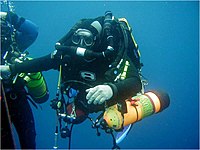
Photo from wikipedia
Abstract Semi‐aquatic mammals have secondarily returned to the aquatic environment, although they spend a major part of their life operating in air. Moving both on land, as well as in,… Click to show full abstract
Abstract Semi‐aquatic mammals have secondarily returned to the aquatic environment, although they spend a major part of their life operating in air. Moving both on land, as well as in, and under water is challenging because such species are considered to be imperfectly adapted to both environments. We deployed accelerometers combined with a depth sensor to study the diving behavior of 12 free‐living Eurasian beavers Castor fiber in southeast Norway between 2009 and 2011 to examine the extent to which beavers conformed with mass‐dependent dive capacities, expecting them to be poorer than wholly aquatic species. Dives were generally shallow (<1 m) and of short duration (<30 s), suggesting that the majority of dives were aerobic. Dive parameters such as maximum diving depth, dive duration, and bottom phase duration were related to the effort during different dive phases and the maximum depth reached. During the descent, mean vectorial dynamic body acceleration (VeDBA—a proxy for movement power) was highest near the surface, probably due to increased upthrust linked to fur‐ and lung‐associated air. Inconsistently though, mean VeDBA underwater was highest during the ascent when this air would be expected to help drive the animals back to the surface. Higher movement costs during ascents may arise from transporting materials up, the air bubbling out of the fur, and/or the animals’ exhaling during the bottom phase of the dive. In a manner similar to other homeotherms, beavers extended both dive and bottom phase durations with diving depth. Deeper dives tended to have a longer bottom phase, although its duration was shortened with increased VeDBA during the bottom phase. Water temperature did not affect diving behavior. Overall, the beavers’ dive profile (depth, duration) was similar to other semi‐aquatic freshwater divers. However, beavers dived for only 2.8% of their active time, presumably because they do not rely on diving for food acquisition.
Journal Title: Ecology and Evolution
Year Published: 2018
Link to full text (if available)
Share on Social Media: Sign Up to like & get
recommendations!